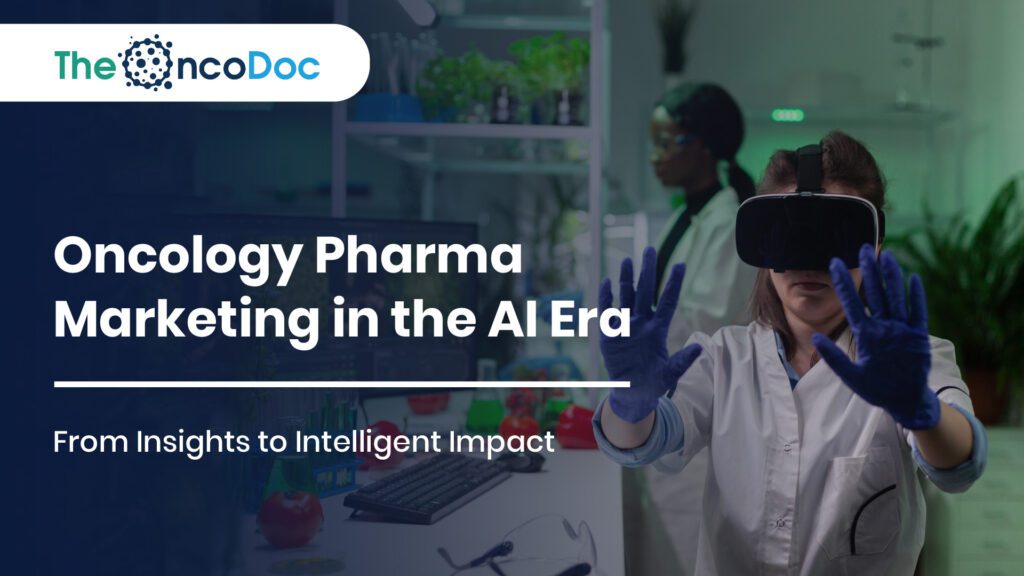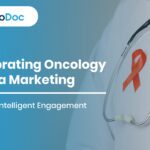Introduction: The Paradigm Shift in Oncology Engagement
Over the past ten years, there has been a significant change in the oncology scene. A new marketing strategy based on relevance, intelligence, and empathy is required due to the confluence of precision medicine, intricate treatment plans, and changing patient expectations. In this complex, high-stakes setting, traditional pharmaceutical marketing methods that rely on volume-based outreach and one-size-fits-all message are ineffective.
Artificial Intelligence (AI) offers pharma a unique opportunity to transform how it communicates, educates, and supports oncology stakeholders, from clinicians to patients to health systems. When deployed ethically and strategically, AI becomes more than a tool, it becomes a bridge connecting innovation with implementation, and brands with trust.
This article explores how AI can catalyze intelligent impact in oncology pharma marketing, delivering value where it matters most: at the intersection of data, dialogue, and decisions.
Section 1: Understanding Today’s Oncology Stakeholders
Oncology is no longer a monolith. The ecosystem is shaped by varied personas, each with unique information needs and behavioral patterns. AI helps decode this complexity through intelligent segmentation.
This diversity underscores a pressing reality: generic campaigns alienate more than they engage. Precision communication, grounded in data, is now table stakes.
Section 2: From AI Insights to Human-Centered Pharma Engagement (250 words)
Artificial Intelligence is not here to replace the human element in pharma marketing, it’s here to enhance empathy with intelligence. In oncology, where clinical choices are complex and emotionally charged, the ability to craft communication that aligns with a clinician’s real-world priorities is more valuable than ever. AI allows marketers to move beyond assumptions by turning fragmented digital signals into actionable insights.
By analyzing digital footprints, content preferences, and behavioral patterns, AI enables the design of hyper-relevant campaigns that reflect clinical urgency, treatment stage, and emotional tone.
Key Applications Include:
- Natural Language Processing (NLP): Continuously scans research papers, EMRs, clinical forums, and medical news to identify emerging clinical concerns, such as rising interest in biomarker resistance or new combination regimens in mCRC.
- Predictive Analytics: Scores HCPs on likelihood of early adoption for new therapies based on engagement history, specialty trends, and peer influence, enabling precision in rollout timing and channel selection.
- Sentiment Analysis: Evaluates clinician reactions across channels, webinars, e-mails, social posts, or rep interactions, to fine-tune message tone, visual language, and follow-up cadence.
With these capabilities, pharma marketers can shift from static, one-way communication to fluid, feedback-responsive campaigns. The result is a dynamic dialogue, where content evolves based on clinician needs, and relationships are nurtured, not interrupted. AI, when used thoughtfully, becomes the engine of authentic, human-centered oncology engagement.
Section 3: AI-Enhanced Personalization in Clinical Communications
Personalization in pharma is evolving from name-tags in emails to behavior-responsive engagement. AI allows segmentation not just by specialty or geography, but by clinical mindset and decision context.
Example Campaign Architecture:
- Segment A: Evidence-Seekers
- Receive dynamic content feeds with meta-analyses, RWE dashboards, and consensus statements
- Segment B: Time-Pressed Generalists
- Get fortnightly bulletins, 2-minute podcasts, and infographics
- Segment C: Multilingual Practitioners
- Access culturally and linguistically tailored videos and CME modules
This shift from static segmentation to fluid, AI-updated clusters drastically improves open rates, time-on-content, and downstream impact.
Section 4: AI in Action – Omnichannel Touchpoint Optimization
In an omnichannel world, message consistency is critical, but message form must flex across platforms. AI-driven orchestration platforms (e.g., Salesforce Health Cloud, Veeva Nitro) analyze engagement metrics in real-time to adapt content type, timing, and sequence.
Clearly, oncologists favor formats that combine brevity with depth. AI tools track individual preferences and auto-adjust content paths to align with behavior, reducing cognitive overload while enhancing message retention.
Section 5: Real-World Evidence (RWE) – From Static Data to Strategic Decision-Making (250 words)
Real-World Evidence (RWE) is increasingly vital in oncology, offering insights into treatment effectiveness, patient behavior, and safety outcomes outside controlled trial settings. However, the sheer volume of data can overwhelm rather than enlighten if not presented thoughtfully. To avoid this, pharma must transition from static RWE dissemination to clinically aligned, AI-curated decision support tools.
AI enables a smarter approach to RWE by analyzing past user interactions, specialty focus, and digital behavior to determine what kind of evidence resonates with different oncologists.
Strategic Implementation Includes:
- Transforming complex registries and insurance claims into intuitive, interactive dashboards, allowing users to filter by indication, stage, and regional demographics.
- Focusing on contextual specificity, such as showcasing “RWE among Indian HER2-negative breast cancer patients on biosimilars,” instead of relying solely on generalized global outcomes.
- Adopting adaptive content logic, where oncologists treating metastatic disease receive second- and third-line outcome data first, while those managing early-stage cases are shown neo-adjuvant or adjuvant insights.
By leveraging AI to match the right RWE to the right user at the right moment, pharma can make this data not only accessible but actionable.
When delivered with relevance and clarity, RWE shifts from being a post-marketing checkbox to a clinically influential asset that enhances oncologist confidence and supports evidence-based treatment decisions. This alignment boosts both therapeutic adoption and trust in the brand, achieving true marketing impact rooted in scientific value.
Section 6: AI + HCP Education = Smarter, Targeted Learning (200 words)
Clinician education remains a vital pillar of responsible pharma engagement, especially in oncology, where therapeutic complexity continues to grow. Artificial Intelligence is now transforming this space by enabling adaptive, personalized learning journeys for healthcare professionals (HCPs).
AI-powered educational technologies may customize the way content is delivered according to each learner’s unique learning preferences, knowledge gaps, and therapeutic interests, making the experience more effective and pertinent.
Example – Intelligent CME Pathways:
- HCPs begin with a brief diagnostic pre-test to assess baseline understanding
- AI dynamically adjusts learning content based on the user’s performance and confidence levels
- For instance, those scoring low on adverse event management receive targeted case simulations, while high performers are routed toward trial interpretation or patient-reported outcome modules
- Post-assessments measure knowledge acquisition and help fine-tune future educational tracks
These systems promote deeper engagement while ensuring that educational content is clinically relevant and personalized. Moreover, they support Continuing Medical Education (CME) compliance by delivering accredited modules in a user-centric, flexible format.
For pharma, this approach represents a dual advantage: improving knowledge transfer and strengthening brand credibility. For clinicians, it offers time-efficient, meaningful learning that evolves with their practice needs, a true win-win powered by AI.
Section 7: Bridging Clinical + Public Health Gaps with AI
Pharma’s role now extends beyond product marketing. In oncology, companies must support health systems, especially in LMICs, where screening, diagnosis, and follow-up are patchy.
By partnering with state NCD cells, NGOs, and digital health startups, pharma can align AI efforts with national objectives, enhancing both reach and reputation.
Section 8: AI-Driven Adherence Nudges: Precision Support for Patients
Adherence to oral oncology regimens remains a critical challenge. Systems with AI capabilities can identify patients who are at danger and initiate tailored therapies.
Real-World Case:
A pharma-backed AI program in Southeast Asia monitored patients on oral TKI therapies through:
- Wearable data (sleep patterns, HRV)
- Digital diaries and pill tracking
- Mood self-reports
When anomalies arose (e.g., poor sleep + skipped logs + low mood), the system:
- Notified the care navigator
- Sent a motivational SMS in the patient’s native language
- Scheduled a tele-call within 24 hours
Outcomes:
- 31% improvement in 90-day adherence
- 12% increase in reported patient satisfaction
AI enables pharma to extend its value beyond the prescription pad into real-world, human impact.
Section 9: Upholding Ethics and Transparency in AI-Enabled Pharma Marketing (200 words)
As AI becomes central to oncology pharma marketing, its power must be matched by unwavering ethical responsibility. In a field where trust is paramount, ethical AI practices are not optional, they are essential for sustainable, credible engagement.
Pharma must commit to the following foundational principles:
- Bias Auditing: Routinely assess AI training data to avoid reinforcing systemic disparities, such as the underrepresentation of rural populations, minority groups, or lower-income regions.
- Transparency: Clearly disclose when AI is used to generate content, guide recommendations, or influence personalization, especially in clinician-facing materials.
- Regulatory Compliance: Align with local and international standards such as UCPMP (India), IFPMA (global), and GDPR (EU), ensuring responsible use of data and communication practices.
- Consent Management: Actively obtain and manage informed consent from HCPs and patients, particularly in real-world data usage, behavior tracking, or predictive targeting scenarios.
Building trustworthiness is the goal of ethical AI, not merely avoiding fines.When clinicians and patients know that AI-driven engagement is accurate, unbiased, and respectful of their privacy, it fosters trust and long-term collaboration.
In oncology, where every message can influence life-altering decisions, ethical AI isn’t a safeguard, it’s a strategic imperative.
Section 10: Metrics That Matter – Redefining Success in the AI-Driven Era (200 words)
In the age of AI-powered pharma marketing, conventional metrics like email open rates, click-through percentages, or social impressions no longer provide a complete picture of campaign effectiveness, especially in oncology, where decisions are evidence-driven and context-specific. Success today demands a deeper understanding of behavioral engagement and clinical influence.
Pharma must switch to intelligent, relevance-based KPIs that transcend volume and vanity in order to properly evaluate impact.
Key indicators include:
- Average time spent on high-value scientific content, reflecting meaningful consumption
- Shifts in prescribing behavior within key geographies or specialties after targeted campaigns
- Quality of feedback from CME or educational sessions, analyzed using NLP tools to detect sentiment and depth
- Percentage of HCPs engaging with three or more touchpoints within a defined window, indicating sustained interest
AI analytics platforms now enable real-time aggregation and visualization of these data points, offering marketers actionable insights. These insights fuel agile, data-informed campaign optimization, allowing brand teams to refine messages, formats, and timing on the fly.
Ultimately, success is no longer defined by how many people see the message, it’s about who acts on it, how, and why. The new norm for cancer involvement is this change from reach to relevance.
Section 11: Future Outlook – The Next Leap for AI in Oncology Pharma Marketing (250 words)
The future of oncology pharma marketing lies at the intersection of Artificial Intelligence and immersive technologies like Extended Reality (XR). As these technologies converge, pharma’s ability to create deeply engaging, clinically impactful experiences will be redefined.
Imagine a world where mixed-reality tumor boards allow medical representatives to virtually join oncologists in immersive discussions, offering real-time support based on AI-analyzed trial data. Or AI-powered avatars, modeled on leading Key Opinion Leaders (KOLs), available 24/7 to deliver microlearning modules in regional languages, bridging access gaps in medical education.
Emerging interfaces may even harness emotion-recognition AI, which senses stress, confusion, or interest levels in real-time and dynamically adjusts the tone, pace, or complexity of patient education content. These tools can dramatically improve comprehension and empathy in patient communications.
Equally transformative is the upcoming integration of AI with real-time Electronic Health Records (EHRs). Such systems can drive next-best-action marketing, delivering treatment suggestions, patient support tools, or updated guidelines right within a clinician’s digital workflow, at the point of care.
These aren’t distant concepts, they are fast approaching realities. Early pilots are already underway in global innovation hubs. To stay ahead, pharma marketers must begin future-proofing their strategies today by investing in adaptive infrastructure, ethical frameworks, and collaborative R&D.
The goal is clear: shift from static, one-way communication to intelligent, interactive, and clinically aligned engagement that supports oncology professionals where and when it matters most. Those who lead this evolution will shape the next decade of oncology impact.
Conclusion: Intelligence with Intention
The oncology community does not want louder pharma. It wants smarter, more respectful, and clinically aligned pharma.
AI enables marketers to become knowledge facilitators, relevance curators, and improve patient outcomes. But this transformation demands intent, investment, and integrity.
When intelligence is paired with empathy, and data with dialogue, pharma can earn something far more powerful than mindshare, it can earn trust. And in the fight against cancer, trust isn’t a soft metric. It’s the foundation of progress.
The Oncodoc team is a group of passionate healthcare and marketing professionals dedicated to delivering accurate, engaging, and impactful content. With expertise across medical research, digital strategy, and clinical communication, the team focuses on empowering healthcare professionals and patients alike. Through evidence-based insights and innovative storytelling, Hidoc aims to bridge the gap between medicine and digital engagement, promoting wellness and informed decision-making.



